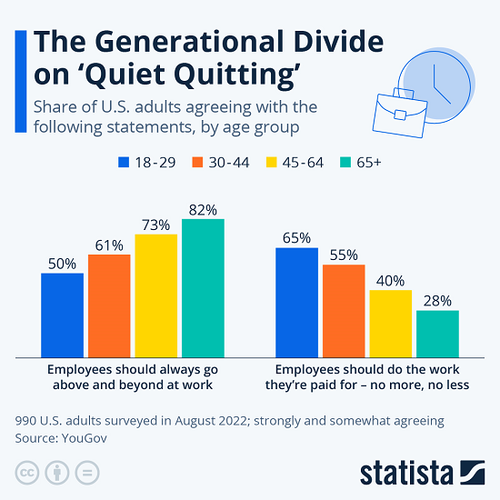The Easy Jobs Are (Mostly) Gone
Authored by Charles Hugh Smith via OfTwoMinds blog,
My projections are: less high-quality work gets done; less work of any quality gets done; those carrying most of the weight burn out and quit and everyone wonders why the quality of goods and services is sinking to new lows.
Since we only keep track of what we measure, whatever isn’t easily quantifiable isn’t even on the radar screen. While we measure the number and type of jobs and the percentage of the populace who are employed, etc., the less quantifiable characteristics of work and jobs are not widely recognized, discussed or understood.
One such difficult-to-quantify element is how demanding jobs are today compared to the same work a generation or two ago. Take the “burger-flipping” fast-food jobs that are so often dismissed as low-skill work. What few outside the fast-food industry seem to realize is how demanding “burger-flipping” work is now. It is a high-pressure “factory” optimized for production of fast-food meals with the minimum staff.
It is not easy work. Many people can’t keep up the pace and perform all that is demanded.
The same can be said for many other jobs that are assumed to be low-skill and therefore “easy.” In the relentless drive to reduce costs, staffing is trimmed, experienced workers let go and replaced with trainees, and more work is piled on those still on staff.
This is equally true of high-skilled jobs: staffing is reduced, open positions remain open for months or years, the work experience and knowledge of those retiring isn’t matched by the often poorly trained replacement workers.
Managers who once had an admin assistant are now their own admin. The work that was once divvied up among three jobs now falls on one worker.
The obsessive drive to increase profits by reducing labor costs has been the norm for the past 20 years. Globalization is one dynamic pushing ceaseless cost-cutting, and so is the ever-higher costs of labor overhead, with employee healthcare being the primary source of staggering increases in the cost of employees. Note the employees don’t see this cost; they see their take-home pay stagnating but not the soaring costs of healthcare insurance paid by their employer.
This raises another rarely quantified element in jobs/work: the precipitous decline of security. Employers offer laid-off employees contract positions that pay $10 more per hour but offer no healthcare, retirement, disability insurance, etc., all of which cost the employer $15/hour. The employer cuts total costs of labor and offloads all the accounting and management of healthcare, retirement funds, paying estimated taxes for income, Social Security and Medicare, etc. on the newly minted contract worker, many of whom are ill-prepared for these extra burdens of self-employment.
It’s not just that wages have stagnated and job security has dropped away; the workload has increased, often dramatically. Yes, there are still Big Tech jobs that appear to be inessential to the operation of the enterprise, but these are being slashed by the tens of thousands. But as a general rule, the workload has increased while job security and the means to get the job done have both declined precipitously.
This erosion has been so gradual that few seem aware of the dramatic changes in the nature of work/employment over the past 40 years.
Equally consequential declines have occurred in the capacity of the workforce to do difficult, demanding jobs. As the general health of the populace has declined, fewer people have the physical stamina and strength to do the physical work. (Try lifting a hotel mattress to change the sheets. Careful, your back may blow out.)
Others lack the requisite social skills (the demands for these skills have also increased) or intellectual capacity or proper training or the will to sustain demanding work.
Two generations ago, there were still undemanding jobs for people who for whatever reason are unable to do demanding work, or who choose not to. Today, most jobs are demanding.
You see the problem. A workforce with diminishing capacity / will to do demanding work and an employer class that has relentlessly increased demands on the workforce while eroding security.
Many assume whatever work people struggle to do or no longer want to do will be performed by automation/robots. Despite the advances in automation, this assumption may not play out as seamlessly as proponents believe. If jobs could have been done by robots for less money, they would already have been automated. It isn’t quite as easy as it might look from the outside.
My projections based on the above are: less high-quality work gets done; less work of any quality gets done; those carrying most of the weight burn out and quit and everyone wonders why the quality of goods and services is sinking to new lows.
New Podcast: Turmoil Ahead As We Enter The New Era Of ‘Scarcity’ (53 min)
* * *
My new book is now available at a 10% discount ($8.95 ebook, $18 print): Self-Reliance in the 21st Century. Read the first chapter for free (PDF)
Tyler Durden
Sun, 03/05/2023 – 11:30
via ZeroHedge News https://ift.tt/MAyO1Wh Tyler Durden
